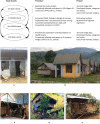Understanding Malaria Persistence: A Mixed-Methods Study on the Effectiveness of Malaria Elimination Strategies in South-Central Vietnam
- PMID: 34950624
- PMCID: PMC8688690
- DOI: 10.3389/fpubh.2021.742378
Understanding Malaria Persistence: A Mixed-Methods Study on the Effectiveness of Malaria Elimination Strategies in South-Central Vietnam
Abstract
Despite the scale-up of vector control, diagnosis and treatment, and health information campaigns, malaria persists in the forested areas of South-Central Vietnam, home to ethnic minority populations. A mixed-methods study using an exploratory sequential design was conducted in 10 Ra-glai villages in Bac Ai district of Ninh Thuan province to examine which social factors limited the effectiveness of the national malaria elimination strategy in the local setting. Territorial arrangements and mobility were found to directly limit the effectiveness of indoor residual spraying and long-lasting insectidical treated nets (LLINs). Households (n=410) were resettled in the "new villages" by the government, where they received brick houses (87.1%) and sufficient LLINs (97.3%). However, 97.6% of households went back to their "old villages" to continue slash-and-burn agriculture. In the old village, 48.5% of households lived in open-structured plot huts and only 5.7% of them had sufficient LLIN coverage. Household representatives believed malaria could be cured with antimalarials (57.8%), but also perceived non-malarial medicines, rituals, and vitamin supplements to be effective against malaria. Household members (n = 1,957) used public health services for their most recent illness (62.9%), but also reported to buy low-cost medicines from the private sector to treat fevers and discomfort as these were perceived to be the most cost-effective treatment option for slash-and-burn farmers. The study shows the relevance of understanding social factors to improve the uptake of public health interventions and calls for contextually adapted strategies for malaria elimination in ethnic minority populations in Vietnam and similar settings.
Keywords: Vietnam; elimination strategies; ethnic minority; malaria; malaria persistence; mixed methods study.
Copyright © 2021 Nguyen, Gryseels, Tran, Smekens, Gerrets, Nguyen and Peeters Grietens.
Conflict of interest statement
The authors declare that the research was conducted in the absence of any commercial or financial relationships that could be construed as a potential conflict of interest.
Figures

References
-
- WHO . World Malaria Report 2020: 20 Years of Global Progress and Challenges. Geneva: WHO; (2020).
-
- Warrell DA, Gilles HM. Essential Malariology. 4th Edn. Boca Raton, FL: CRC Press. (2017). 10.1201/9780203756621 - DOI
-
- WHO . Strategy for Malaria Elimination in the Greater Mekong Subregion (2015-2030). Washington, DC: WHO; (2015).
Publication types
MeSH terms
LinkOut - more resources
Full Text Sources
Medical

